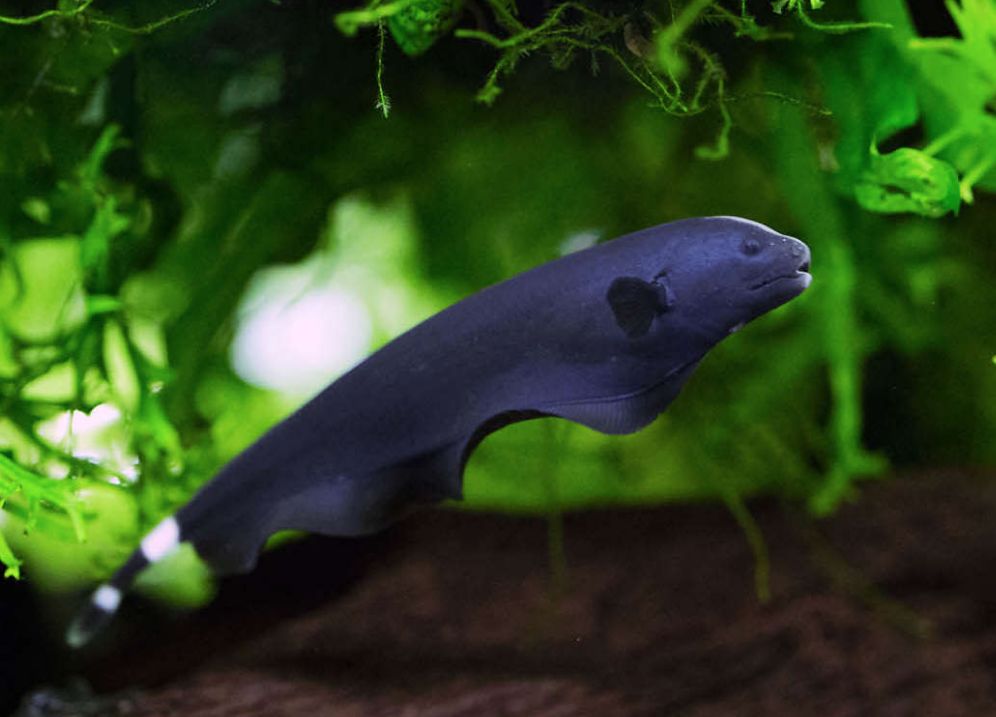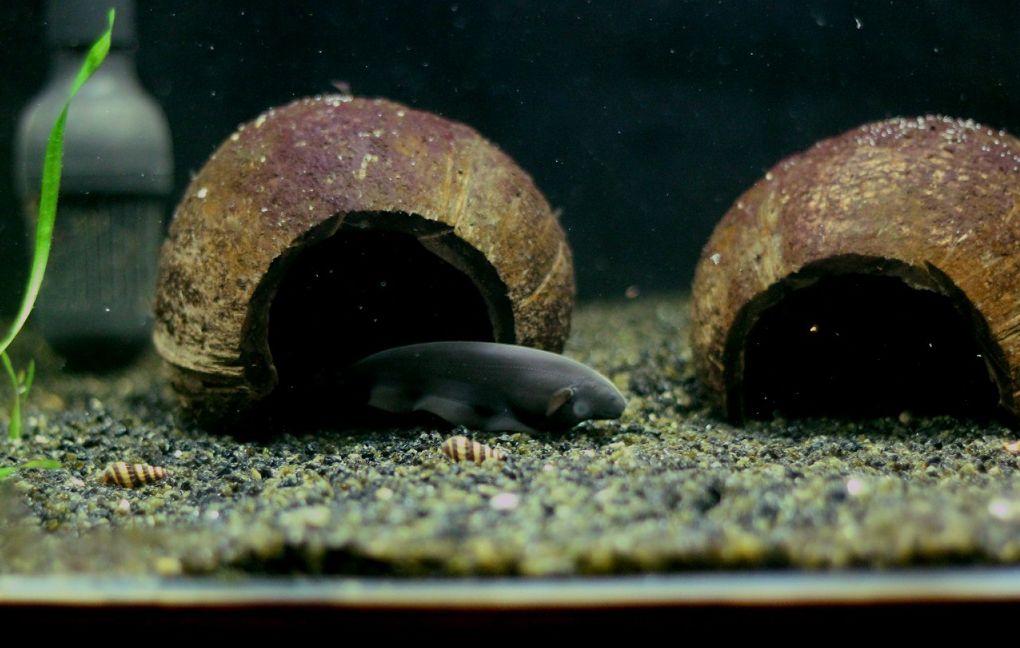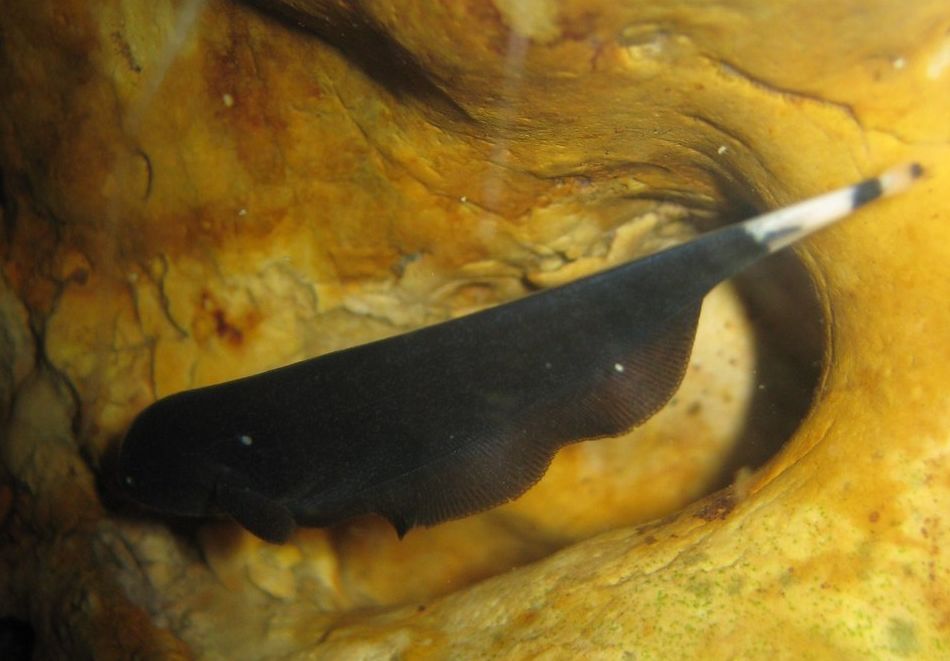The black ghost knife fish (Apteronotus albifrons) is an intriguing choice for freshwater aquariums. Known for its unique look and behavior, this fish is a favorite among hobbyists. It’s mostly active at night and tends to be shy during the day, often hiding at the bottom of the tank.
To keep a black ghost knife fish happy and healthy, you’ll need a large tank with lots of hiding spots and a sandy bottom. They’re sensitive to water conditions, so regular tank maintenance and good filtration are essential. This fish is a fascinating addition to an aquarium, offering both beauty and a bit of a challenge for those willing to meet its needs.

Contents
Habitat in the wild
The black ghost knife fish (Apteronotus albifrons) hails from the upper Amazon River basin, spanning Bolivia, Peru, Brazil, and Colombia. This region’s slow-moving, dark waters, rich in tannins from decaying leaves, create the ideal environment for this fascinating species.
In the wild, black ghost knife fish are commonly found in calm, stagnant waters surrounded by dense vegetation. They thrive in areas with submerged logs, tangled roots, and aquatic plants, which provide essential cover and shelter. Their black coloration helps them blend seamlessly into these shadowy, murky environments, offering protection from predators and making them less visible to prey.
This fish is predominantly nocturnal, spending much of the day hidden under debris or in natural hollows along the shore. The low-light conditions of its habitat result in poor eyesight, so the black ghost knife fish relies on an intriguing adaptation to navigate and hunt. It generates a weak electric field around itself, which allows it to detect movement and sense objects in the dark or murky water. This electroreception not only aids in hunting but also plays a crucial role in communication and locating potential mates.

Description
The Apteronotus albifrons is a striking and distinctive species with a range of unique physical characteristics. Its elongated, scaleless body tapers gracefully towards the tail, giving it a sleek and streamlined appearance. The fish has a notably flat abdomen, a large head with a pointed mouth, and lacks both abdominal and dorsal fins. Instead, it boasts a well-developed anal fin that extends from just behind the head to the tail, allowing it to move fluidly in any direction through the water.
The black ghost knife fish’s tail fin is relatively small, and its body is predominantly black with a striking white stripe running along its back. This stripe is complemented by two yellow-white transverse stripes on the tail stalk. The coloration, which ranges from dark brown to nearly black, is highlighted by these distinctive markings, including the white stripe that inspired its Latin name “albifrons,” meaning “white forehead.”
A standout feature of Apteronotus albifrons is its ability to produce electric organ discharges (EODs). These electrical signals are crucial for navigation, communication, and hunting. By emitting weak electrical pulses and interpreting the distortions caused by nearby objects, the fish can effectively navigate and locate prey even in the dark, murky waters of its natural habitat. This electroreception capability allows the black ghost knife fish to thrive in environments where vision alone would be inadequate.
Size
In the wild, the black ghost knife fish can reach an impressive length of up to 50 cm (20 inches). However, in the confines of an aquarium, it typically grows to a slightly smaller size, averaging between 30 to 45 cm (12 to 18 inches). While some individuals may approach the upper end of this range, it’s important to note that not all black ghost knife fish will reach these maximum sizes.
Several factors can influence the growth and final size of a black ghost knife fish in captivity. Genetics play a significant role, but diet and environmental conditions, such as tank size and water quality, also impact how large the fish can grow. Ensuring optimal care and a suitable environment can help the fish reach its full potential size.
Lifespan
Black ghost knife fish (Apteronotus albifrons), have an average lifespan of around 10 to 15 years in captivity. However, with proper care and favorable conditions, they have been known to live even longer, potentially reaching up to 20 years or more. Providing a suitable environment, appropriate diet, and regular monitoring of their well-being can contribute to their longevity.
| Characteristic | Description |
|---|---|
| Scientific Name | Apteronotus albifrons |
| Common Names | Black ghost knifefish, Brown ghost knifefish |
| Family | Apteronotidae |
| Native Habitat | Freshwater rivers, streams, and flooded areas in South America |
| Distribution | Amazon and Orinoco river basins, Brazil, Venezuela, Colombia |
| Size | Up to approximately 50 centimeters (20 inches) in length |
| Body Shape | Elongated, laterally compressed with a long, thin tail |
| Coloration | Dark brown to black with a distinctive white stripe along body |
| Head | Flattened with a long snout |
| Anal Fin | Single, ribbon-like fin extending along the length of the body |
| Behavior | Nocturnal, primarily active during the night |
| Electric Organ Discharge | Produces weak electrical signals for navigation and prey detection |
| Diet | Carnivorous, feeding on small invertebrates, insects, crustaceans |
| Preferred Habitat | Slow-moving or stagnant waters with dense vegetation |
| Tank Requirements (in captivity) | Large aquarium, plenty of hiding places, sandy substrate |
| Sensory Adaptations | Specialized electric sense for navigation and hunting prey |

Difficulties in keeping
The black ghost knife fish is best suited for experienced aquarists due to its specific care requirements and sensitivity. Without scales, this fish is particularly vulnerable to diseases and water contaminants. To help mitigate these risks, it is advisable to use an external filter equipped with a UV sterilizer. This setup helps reduce the likelihood of disease by eliminating harmful pathogens and keeping the water clean.
Additionally, the black ghost knife fish is sensitive to changes in water parameters. Abrupt shifts in temperature, pH, or other factors can stress the fish, so maintaining stable water conditions is crucial for its health.
Being a nocturnal predator, this fish is most active at night. Therefore, it should be fed during the evening or nighttime to align with its natural feeding habits. New tank setups can also be challenging for the black ghost knife fish, as it tends to be timid and cautious in unfamiliar environments. Patience and careful acclimation are key to helping it adjust and thrive in its new home.
Keeping in a tank
Tank size
An adult black ghost knife fish requires a spacious tank due to its size and active nature. For a single black ghost knife fish, a tank with a minimum capacity of 75 gallons (284 liters) is recommended. However, providing a larger tank is advantageous, as it offers more swimming space and a more comfortable environment for the fish.
Given its elongated body and active behavior, the black ghost knife fish benefits from a tank that prioritizes horizontal swimming space over vertical height. Ideally, the tank should be at least 4 feet (120 cm) in length to accommodate its needs.
Additionally, black ghost knife fish thrive in calm waters. Therefore, it is crucial to ensure minimal water flow within the tank. If you plan to house multiple black ghost knife fish together, you will need an even larger tank to manage their territorial instincts. Each fish should have enough space to establish its own territory and minimize potential conflicts.
Water parameters
These fish thrive in a temperature range of 25-28°C (77-82°F), which mimics their natural tropical habitat.
Black ghost knife fish prefer slightly acidic to neutral water. The ideal pH range for them is between 6.5 and 7.5. They also tolerate moderate water hardness, with a recommended carbonate hardness of 5-12 dKH (degrees of carbonate hardness) or a general hardness of 2-15°dH (degrees of general hardness).
Filtration
A powerful external filter is a must for such a tank. A combination of mechanical, chemical, and biological filtration is recommended. Regular water changes, typically around 20-30% every two weeks, can help maintain water quality and dilute any accumulated toxins.
The fish produces lots of waste, since it eats protein food and it is sensitive to tank water quality. Using such a filter will help you to solve lots of problems if the fish gets ill. Infectious diseases are much more dangerous for this fish, then for any other tank dweller because it has no scales on its body.
Ammonia and nitrite levels should be maintained at zero. Regular testing and proper filtration are essential to ensure a healthy environment. The presence of ammonia and nitrite can be harmful or even fatal to the fish.
Tank decor
The black ghost knife fish is a nocturnal predator. Most of the time it spends close to the tank bottom. During the day it likes hiding in shelters and leaves them only to feed or at night.
It is better to keep black ghost knife fish alone in a tank, since adult males quite often fight to guard their territory. If you have more than one species in your tank, it is desirable to provide them with large number of shelters (snags, stones, caves etc.) Some aquarists use transparent tubes where the fish feels safe, but at the same time you can see it.
It is desirable to have some floating plants in a tank to create half-light and to create average water flow there.
Diet
The black ghost knife fish is a carnivorous species with a diet that mirrors its wild feeding habits. In its natural habitat, it primarily consumes small invertebrates, insects, crustaceans, and occasionally small fish.
In a home aquarium, the black ghost knife fish continues to thrive on a varied diet of live and frozen foods. Ideal choices include bloodworms, brine shrimp, daphnia, blackworms, and small insect larvae. Additionally, you can offer small pieces of meaty foods such as shrimp, small fish fillets, or finely chopped seafood.
To ensure a balanced diet, supplement their meals with high-quality pellets or flakes specifically formulated for carnivorous fish. Look for products with high protein content that are designed for bottom-dwelling or nocturnal species.
It is best to feed the black ghost knife fish once a day, either just before turning on the tank lights or after the lights are off. This timing aligns with their nocturnal feeding habits. The fish uses its electroreceptors, located along its body, to detect changes in electromagnetic fields and locate its prey, even in the dark or murky water.

Tank mates
Black ghost knifefish are generally peaceful and prefer calm tank mates. Avoid aggressive or fin-nipping species that may harass or stress the knifefish. Compatibility with other fish largely depends on individual temperaments, so closely monitor their interactions when introducing new tank mates. The black ghost knife fish is compatible with any non-aggressive species except small fishes like neon tetra or guppy, which it will treat as food.
Here are some examples of suitable tank mates:
- Large peaceful cichlids: Species like angelfish (Pterophyllum spp.) and some peaceful South American cichlids such as Severums (Heros spp.) or Geophagus species can work well in larger tanks. Ensure that the cichlids are not overly aggressive and can tolerate the knifefish’s presence.
- Larger peaceful catfish: Certain larger catfish species can be compatible, such as larger Plecos (e.g., Bristlenose Plecos – Ancistrus spp.) or larger Corydoras catfish. Choose species that are not aggressive or predatory towards the knifefish.
- Gouramis: Peaceful gourami species like Pearl Gouramis (Trichogaster leeri) can be suitable tankmates, provided they are not overly aggressive or territorial.
Gender differences: male vs female
The black ghost knife fish exhibits minimal sexual dimorphism, meaning there are no significant differences between males and females in terms of coloration, fin shape, or body size. Unlike some other fish species, male and female black ghost knife fish do not have distinct physical traits to differentiate them.
In the wild, fish use electrical pulses to locate each other. Each gender emits electrical signals at different frequencies, which helps males and females find one another for mating. This unique method of communication is essential for their reproductive behaviors and demonstrates the fish’s remarkable adaptation to their environment.
Breeding
Breeding black ghost knife fish requires specific conditions to encourage successful reproduction. First, set up a densely planted tank with plenty of snags and shelters to mimic their natural habitat. A balanced diet is crucial; include live foods such as bloodworms and worms to support the fish’s reproductive health.
Typically, a breeding group consists of 6 to 10 individuals. To stimulate breeding, you can simulate natural rain and drought cycles by periodically flooding and draining the tank. This method helps replicate the seasonal changes that trigger spawning in the wild.
During breeding, the female lays eggs in sheltered spots, such as among snags or in a cave. The eggs are yellow and approximately 2 mm in diameter. Within three days, the eggs hatch into larvae. Providing these conditions and stimuli will increase your chances of successful breeding and healthy offspring.